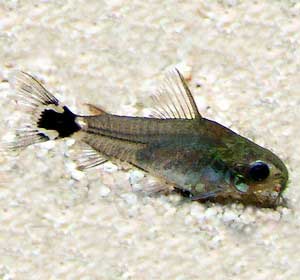
| Species | Dwarf Cory |
|---|---|
| Other names | Dwarf Corydoras |
| Latin Name | Corydoras Hastatus |
| Family | callichthyidae |
| Origin | South America |
| Length | 2,5 - 3,5 cm |
| Temperature | 22 - 26°C |
| Water Hardness | soft - medium hard |
| pH | 7,5 - 6,0 |
| Aquarium Size | 50 L |
| Food | dry, live, frozen, plant |
This fish lives in small creeks, tributaries, ponds, floodplains covered in trees in Argentina, Brazil and Bolivia.
Colour of the body is gray-olive with light under-side and clear fins. There is a black spot with white border on the base of the caudal fin. This spot looks like cross or spear. The fish on the sides has two rows of defensive bony plates which are known as scutes. The first rays of the pectoral fins are transformed into poisonous spikes. This species can breathe with atmospheric air using the intestine. This species is often confused with Pygmy corydoras although differences are clearly visible. This fish has larger spot on the base of the caudal fin and doesn’t have the dark stripe along the lateral line like Pygmy cory. Sex of the fish can be recognized when it is sexually mature. Female is thicker than male in the ventral parts.
This is a small, peaceful and shy species. It can be very easily intimidated by large and aggressive species. It doesn’t compete for food. Fish prefers to live in a group of 6 minimum and it swims at all water levels in the aquarium. These fish often rests on the plant’s leaves. You shouldn’t use the net to catch the fish because you may harm it. You should keep them with other small and peaceful species e.g. dwarf cichlids, microrasboras, danios, species of the Hemigrammus genus, tetras and shrimps. Dwarf corydoras may eat a roe and offspring of other fish and shrimps.
The aquarium should have a lot of plants, space to swim, dimmed light, floating plants, hiding places among roots or branches. You may also keep these fish in biotope tank with sandy substrate, floating pieces of wood, roots, dry leaves of oak or beech which should be changed every few weeks, peat placed in a filtration system.
This is an oviparous species. You should breed it in a separate tank. Aquarium should have fine substrate (sand or gravel), fine and soft-leaved plants, sponge filter with peat. Water should be 24°C, pH=6,5. You transfer group of the fish (more males than females) to the breeding tank and and feed them with plenty of live food. You should do partial water changes (2/3 of the water) on cooler water and you should increase the water flow and aeration when female will be visibly thicker in the ventral parts. You do that every day until the fish start to spawn. Insemination takes place in characteristic "T-position". Male holds female’s barbels in his pectoral fins. He releases sperm. This sperm flows through the female’s pelvic fins where she holds portion of eggs. Then she is looking for the right place to deposit the eggs - usually it is the aquarium glass. The cycle is repeated. The spawn may take a several hours. You should remove the parents after spawning because they eat the eggs. The roe is sensitive to fungal infections. You may add a few drops of methylene blue to the water to protect the roe and you must check and remove the rotten eggs every day. The eggs hatch after several days. The fry starts to swim and feed 2 days later.